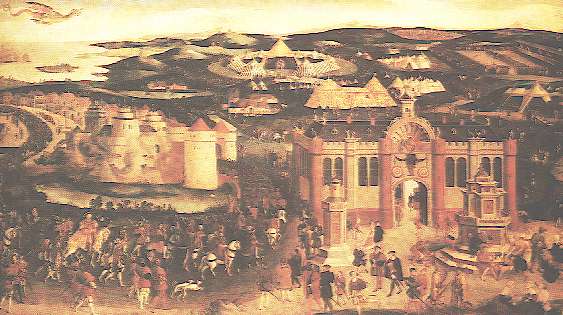Marguerite was a contemporary of King Henry VIII (1491-1547) of England. And her story interesected several times with his or that of 16th Century England -- either directly or through her brother, François I, King of France.
When Marguerite was ten years of age, her mother, Louise of Savoy, proposed her marriage to the Prince of Wales, later King Henry VIII. But his young Henry's father, King Henry VII of England said, "Thanks, but no thanks."
In 1520, Marguerite's brother, King François I of France, met King Henry VIII of Egnland in a field near Calais, in the northwest of France, wich became known as "The Field of the Cloth of Gold".
François hoped for English support against the Holy Roman Emperor, Charles V, and wanted to use all his diplomatic skills to persuade Henry to form an alliance with him.
At the meeting, the two kings tried to impress each other with a brilliant display of their wealth. Amid a forest of gilded tents, hence the name "Field of the Cloth of Gold".
They enjoyed a spectacle of glittering processions, banquets, plays, tournaments, and fireworks. All the courtiers wore garments made from cloth of gold.
After the fun had finished, the two kings retired beneath one of the tents, where they joked together for a while.
But then Henry seized François by the collar (as in the drawing below) and said "My brother, it is necessary that I fight with you."
Henry went on to join forces with Charles V against the French king.
Later, when Marguerite was widowed by the death in 15xx of her first husband, xxx, her brother, François I, proposed her marriage to Henry VIII, then between queens x and y. Fortunately for Marguerite, this Henry also declined.
Anne Boleyn (x-y), 2nd wife of Henry VIII had been lady-in-waiting to Marguerite and was then given the manuscript of Marguerite's controverial poem, Mirror of a Sinful Soul. In turn, this manuscript was given to Ann's daughter, Elizabeth, who (at age 12) translated it from French into English.
Queen Jane Seymour died in chilbirth, bearing the child that became King Edward VI. His untimely death at age 12 led to the reign of Elizabeth I. But this Jane Seymour had been lady-in-waiting to Anne Boleyn (who had been lady-in-waiting to ...).
In 1550, one year after Marguerite's death in France, there appeared in England a poetical work that was singular in many ways.
- It was the only work published in any language by English women before the 1560s.
- It was the only published poem in Latin of any Egnlish women in the 16th century.
- It was the first female-authored econium written in England.
- It was An elegy in 104 distichs on the death of Marguerite of Navarre written by the three young nieces of Jane Seymour (x-y), third wife of Henry VIII.
- It caused such a sensation that, a year after its publication, it reappeared in translations into Greek, Italian and French by famous contemporary poets, xxx Dorat, Des Memes, Du Bellay, Baif, Jacques le Peletier du Mans, and Antoinette de Loynes; along with a list of contributors "that looks like a directory of the Pleiade".
The title was: Annae, Margaritae, Ianae, sororum virginum heroidum Anglarum, in mortem Diuae Margaritae Valesiae, Nauarrorum Reginae, Hecatodistichon.
DO YOU WISH TO SEE THE FRONTPAGE OF THIS FILE.